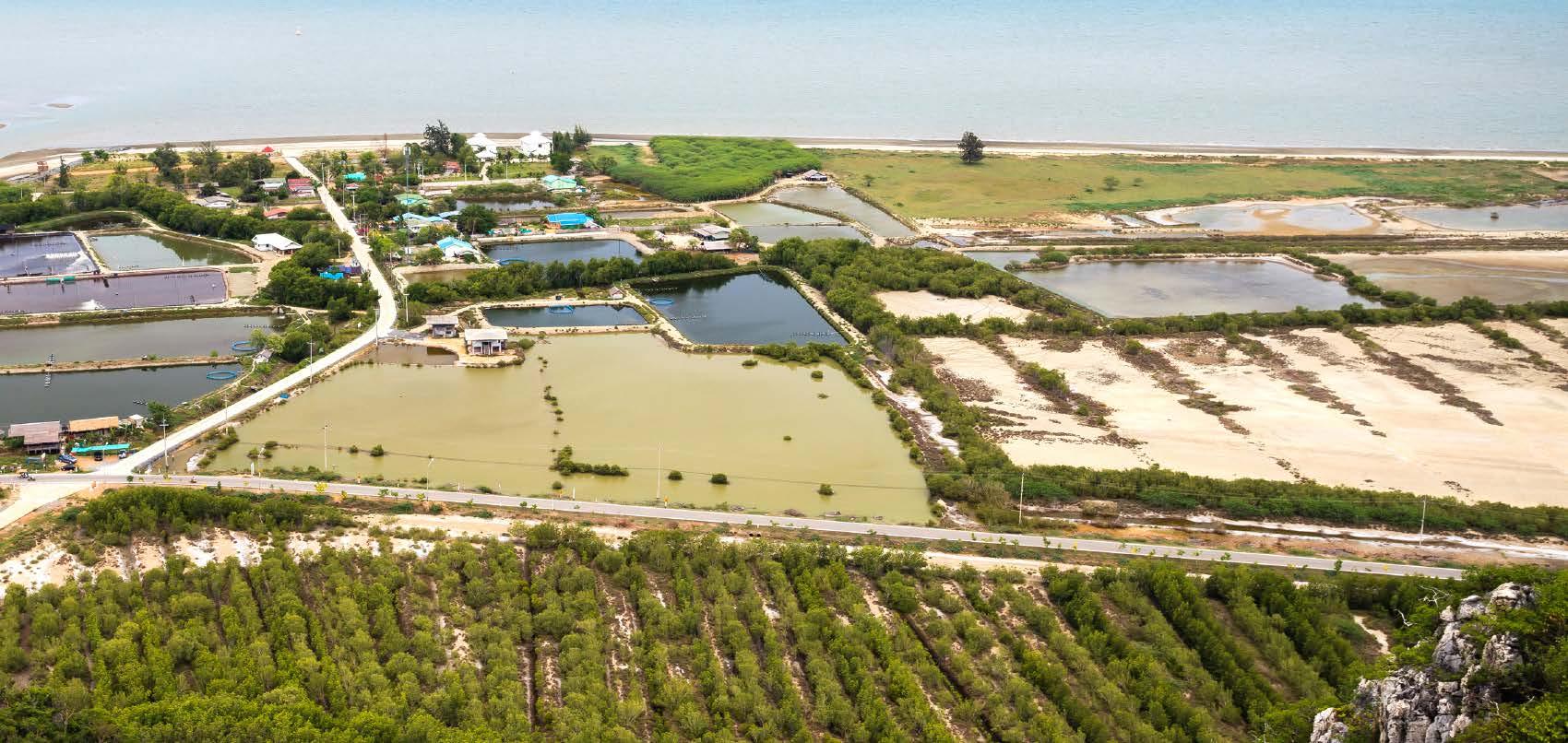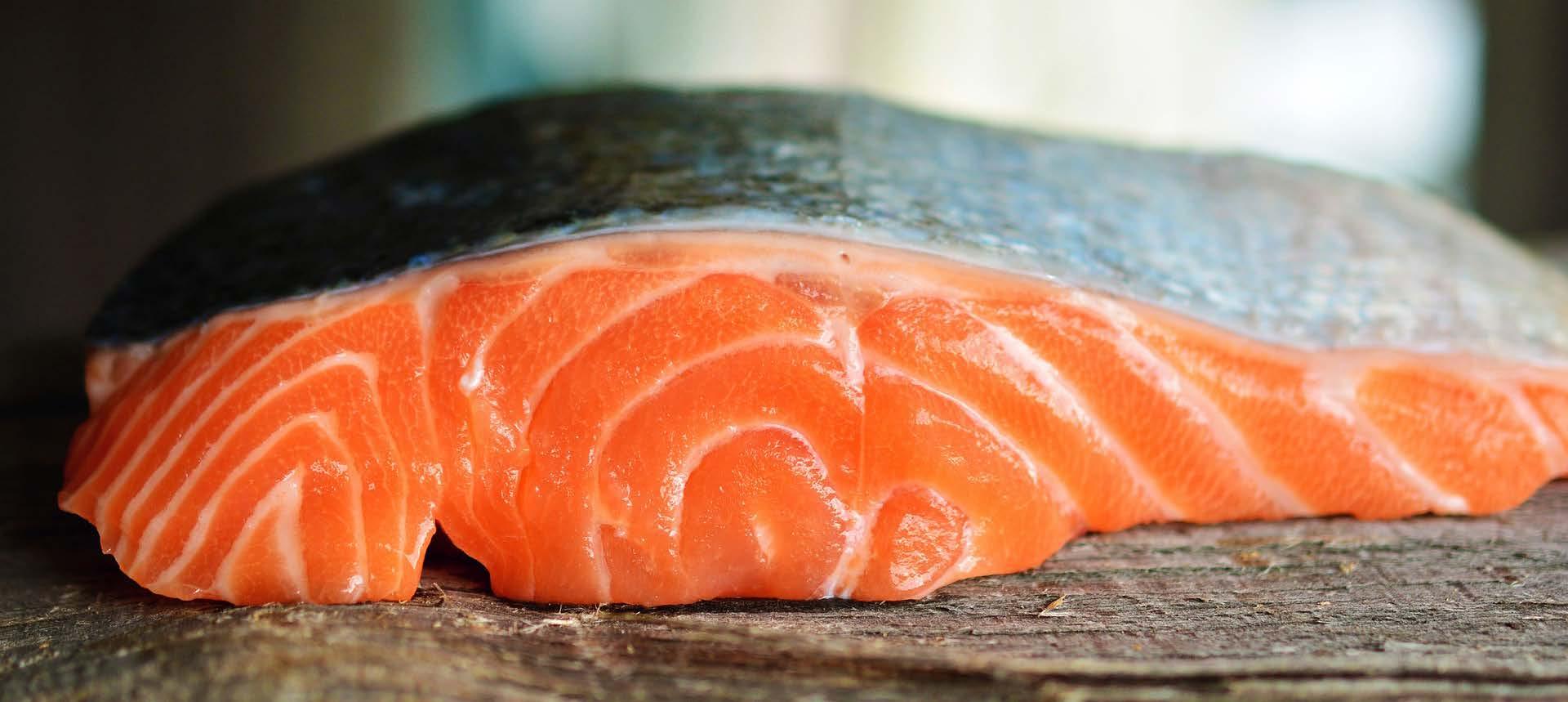
12 minute read
SALMONIDS
Overcoming Barriers to Support the Growth of Land-based Atlantic Salmon Production
By: Greg Fischer, Emma Wiermaa, Chris Good, John Davidson, and Steve Summerfelt *
Support for research and technological development is needed to facilitate the sustainable growth of this industry sector, which is vital to meeting U.S. seafood demand and reduce the national seafood trade deficit. To provide industry with timely and relevant recommendations to combat saprolegniasis and to ensure optimal fillet quality, current research on Land-based closed containment Atlantic salmon production is being carried out at both the University of Wisconsin Stevens
Point Northern Aquaculture Demonstration Facility (UWSP NADF), as well as The Conservation Fund Freshwater Institute (TCFFI) in West Virginia, this article presents relevant information on the matter.
Status of Atlantic salmon in RAS Land-based closed containment (LBCC) salmonid production represents an important and growing sector of the overall aquaculture industry. LBCC fish farm operations utilizing water recirculation aquaculture system (RAS) technologies offer the industry a viable and sustainable means to expand domestic production, while capitalizing on the numerous benefits to this approach, including: enhanced biosecurity, a high degree of control over the fish rearing environment, technologies to effectively capture wastes in order to reduce environmental impact, limiting interaction
between farmed fish and wild populations, and reduced overall carbon footprint by providing increased domestic seafood availability close to local markets.
While most of the Atlantic salmon consumed in the U.S. is imported from Chile, Norway, and Canada, domestic production of Atlantic
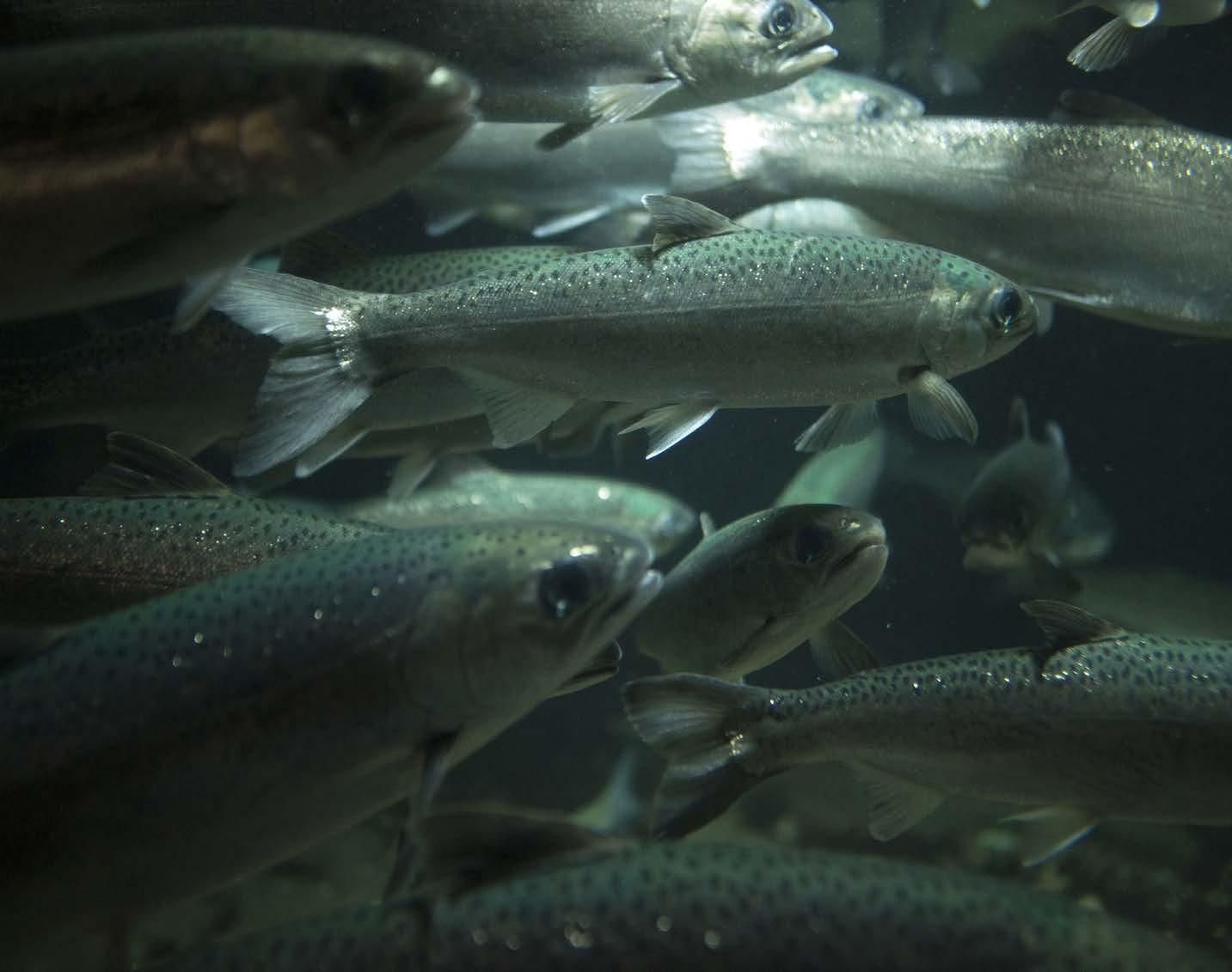
Support for research and technological development is needed to facilitate the sustainable growth of this industry sector, which is vital to meeting U.S. seafood demand and reduce the national seafood trade deficit.
salmon is mostly confined to a relatively small industry in the states of Maine and Washington. In addition, Atlantic salmon net pen farming in Washington State is slated to be phased out by 2025 according to legislation that was passed after a large escape event. However, LBCC production of market size Atlantic salmon is already commencing in the Great Lakes region, specifically in Wisconsin in what is currently the largest land-based salmon aquaponics operation in the world, Superior Fresh, LLC. Even more significantly, domestic production of Atlantic salmon will be enormously increased through other LBCC farms that are planned or already underway in Florida and Maine. Others are planned or are already in the construction phase in other regions of the country. For example, Atlantic Sapphire is currently developing the world’s largest land-based salmon farm just outside Miami, Florida. The company plans to produce about 10,000 metric tons of fish in its first year in 2020, with expansion plans aiming to produce 95,000 met
ric tons of fish by 2026 and 220,000 metric tons by 2031.
Support for research and technological development is needed to facilitate the sustainable growth of this industry sector, which is vital to meeting U.S. seafood demand and reduce the national seafood trade deficit. Continued research and development in LBCC aquaculture production will also facilitate domestic agricultural economic contribution, job growth, and food security.
Challenges Lead to Industry-Applied Research Based on current knowledge, there are several major technical-biological challenges that are encountered when producing market-size Atlantic salmon in LBCC systems, and these challenges include reducing early male maturation, managing saprolegniasis (commonly termed “fungus”) during the parr (fry) and smoltification life stages, and ensuring that the flavor profile of the market-sized harvested fish is free of off-flavor. Fortunately, current research (yet to be published) suggests that use of commercially available all-female diploid and triploid Atlantic salmon eggs could limit problems with early maturation; however, the challenges of saprolegniasis and off-flavor purging still need to be researched and remediated.
To provide industry with timely and relevant recommendations to combat saprolegniasis and to ensure optimal fillet quality, current research is being carried out at both the University of Wisconsin Stevens Point Northern Aquaculture Demonstration Facility (UWSP NADF), as well as The Conservation Fund Freshwater Institute (TCFFI) in West Virginia, to examine these critical areas and to reduce or eliminate the current barriers affecting Atlantic salmon production on land. With support and collaboration from the University of Wisconsin Sea Grant Institute, the project was funded by the National Sea Grant College Program at the National Oceanic and Atmospheric Administration (Silver Spring, Maryland, USA).The project has been coordinated to address and
involve commercial partners including Superior Fresh LLC (Wisconsin) and Riverence/Evaqua LLC (Washington) when developing solutions to these problems. Their involvement in the work plans include fullscale trials at their facilities, technical assistance, review oversight, and products such as fish or eggs, all of which are critical to the success of this work. According to Steve Summerfelt at Superior Fresh, LLC, “We have been ecstatic to collaborate with scientists at the UWSP Northern Aquaculture Demonstration Facility and the Freshwater Institute because the practical results from this Sea Grant funded research project can immediately benefit our production practices. Some of their early findings have already helped us optimize purging SOP’s and improve fish welfare during early life stages.”
Overcoming the Barriers Saprolegniasis Effective therapeutic strategies must be developed not only to reduce losses to saprolegniasis but also to maintain adequate water quality for fish health and performance, i.e. to limit impact on RAS biofiltration capacity. The development of such therapeutic approaches would be highly beneficial to industry, both for RAS smolt production and LBCC growout, and will ultimately enhance the economic viability of RAS operations. The therapeutic approach was also intended to provide an alternative treatment more benign than formaldehyde, which has been traditionally used to treat saprolegniasis even though it is an embalming agent, a mutagen, and a carcinogen.
This project evaluated whether saprolegniasis is reduced with the use of various low-dose concentrations of peracetic acid and/or hydrogen peroxide treatments during vulnerable fry stages while maintaining acceptable fish welfare. Increases
in fry survival through the daily administration of these therapeutants has been documented through these experiments and will be reported in upcoming peer-review publication.
At UWSP NADF and TCFFI, parallel research studies were conducted to examine the efficiency of hydrogen peroxide and peracetic acid to control saprolegniasis. At UWSP NADF, fifteen replicated, flow-through 0.24m 3 circular tanks were utilized inside the 9,520ft² research facility in Bayfield, Wisconsin (Figure 1). At TCFFI, fifteen replicated flow-through 0.5m 3 circular tanks were utilized in Shepherdstown, West Virginia (Figure 2).
At UWSP NADF and TCFFI, the same experimental approach and systems described below were applied to 5g salmon fry, which are followed during their vulnerable early rearing life-stage (up to 20g) to assess the efficacy of the two target therapeutants for saprolegniasis prevention or remediation on pre-smolt fish.
Additional stressors including daily handling and density elevation were applied during this period to increase the likelihood of clinical saprolegniasis. Treatments were applied Monday - Friday as follows; 3 tanks served as controls where no treatments administered, while 3 tanks were provided with daily bath treatments of either 0.2 mg/L or 0.5 mg/L peracetic acid, or 15 mg/L or 30 mg/L hydrogen peroxide. Throughout the treatment study, fish were observed daily which will include visible saprolegniasis (confirmed via wet-mount light microscopy) and daily mortalities. Survival curves for each treatment are currently being developed and compared statistically. Throughout the treatment period, gill and skin tissue samples were also collected for histopathology in order to assess fish health under the treatment conditions.
Although data have yet to be published, initial findings showed
Land-based closed containment (LBCC) salmonid production utilizing water recirculation aquaculture system (RAS) technologies offer the industry a viable and sustainable means to expand domestic production, while capitalizing on the numerous benefits to this approach.
that prophylactic daily administration of low-dose hydrogen peroxide during the vulnerable fry life-stage significantly improved fry survival through reduced opportunistic infections compared to controls; daily administration of low-dose peracetic acid also improved survival, although to a lesser extent than hydrogen peroxide.
Off-Flavor Elimination Fillets containing off-flavor are often rejected and can cause negative consumer perception of RAS farm-raised products. Unresolved off-flavor problems can lead to devastating consequences for the producer if their reputation is tainted and they cannot readily sell their product. Off-flavor is due to the naturally produced chemical compounds, geosmin and 2-methylisoborneol, which are metabolic products of certain species of bacteria. These compounds, which are relatively common in RAS water, but at levels measured in parts per trillion, are primarily taken up by fish through the gills and absorbed within lipid-rich tissue. These compounds can also diffuse out of fish upon transfer to biofilm-free systems with significantly lower offflavor compound concentrations. In aquaculture, this physiological
Figure 1
The UWSP NADF flow-through research system utilizing twenty-seven 0.24m3 circular replicated tanks in a controlled environment room.
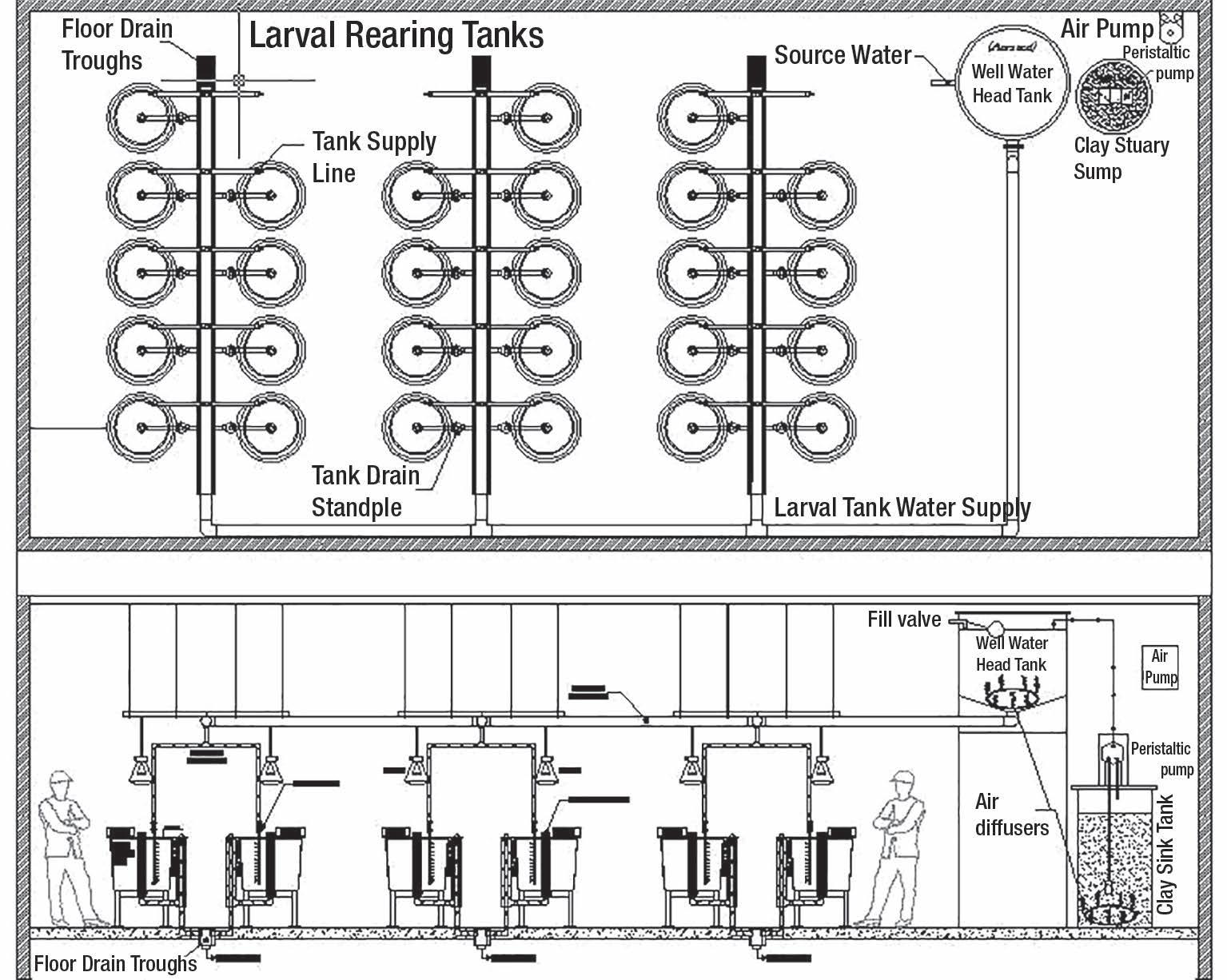
process serves as an advantageous mechanism for off-flavor reduction, and is referred to as depuration or purging. Depuration systems are usually single-pass or partial reuse systems that are sanitized between purge cohorts to eliminate bacterial
biofilms and hence the major source of off-flavor compounds. This project investigated ways to optimize depuration procedures and possibly shorten the depuration time, saving substantial time, water and energy in commercial farms.

Figure 2
The 12 replicated partial-water reuse systems (back row) at TCFFI, Shepherdstown, WV.
At TCFFI, the effect of swimming speed and reduced dissolved oxygen concentration on the rate of geosmin removal from market-size Atlantic salmon was investigated. TCFFI also tested the effect different makeup water flushing rates on the kinetics of geosmin removal from fixed biomasses of market-size Atlantic salmon. The studies utilized 12 replicated partial-water reuse systems, operated at 13-14ºC, within a biosecure, controlled-environment aquaculture research building (Figure 2).
Simultaneously, at UWSP NADF, geosmin depuration research was conducted utilizing the facility’s coldwater RAS (Figure 3). Atlantic salmon were provided to UWSP NADF for conducting geosmin research (Figure 4). With the onset of purging, each tank was operated in flow-through with 8.0ºC oxygenated well water. Two makeup water flow treatments were applied, with three replicates per hydraulic flushing rate. The flow rates for the purging study were set for 900 liters per kilogram of fish for seven days of purging. Flow rates and water quality was monitored and verified during the study period.
There are several major technicalbiological challenges that are encountered when producing market-size Atlantic salmon in LBCC systems, such as reducing early male maturation, managing saprolegniasis during the parr (fry) and smoltification life stages, and ensuring that the flavor profile of the market-sized harvested fish is free of off-flavor
Figure 3
The coldwater recycle system at UWSP-NADF utilized for culturing Atlantic salmon for the study.

At both UWSP NADF and TCFFI, water and fillet and MIB were quantified through collaboration with USDA Research Scientist Casey Grimm, Food Processing and Sensory Quality Research, USDA ARS, New Orleans, LA.
Depurating Geosmin and MIB From Atlantic Salmon Raised in RAS- Commercial Application Superior Fresh, LLC. tested two flushing flows of well water at 10°C through each purge tank when operating using standard operating practices (SOPs). Considering the 5,500-gallon (20.8 m 3 ) purge system volume, mean hydraulic retention times of 3.7 hr. and 7.4. The low flushing flow was tested to see if well water could be spared without compromising the effectiveness of depuration. The purge tank was loaded with fish during each event according to SOP.
Each treatment was replicated three times, i.e., repeated once in 3 different purge systems during the

Figure 4
Market size Atlantic salmon (~8kg) at UWSP NADF used for depuration research.
study. Superior Fresh collected 72 harvest-size salmon and approximately 120 water samples. Six fish were collected at time zero (start of purge) and six fish were collected after 7 days of purging. Duplicate water samples were collected from the water entering the tank and exiting the tank at time 0, 3 hr., 24 hr., 2 days, 3 days, 4 days, and 7 days of purge. To ensure that all fish were on-flavor when harvested to market during these trials, water flow through the low-flushing treatments
was significantly increased after samples were collected on day 7 to ensure that these fish would purge effectively by day 10.
USDA ARS scientist, Casey Grimm, measured the geosmin and MIB concentration in fillet and water samples. Results were shared at the first RAS-N workshop in December of 2019.
The Outcomes The overreaching goal of this project is to provide scientifically validated research that will allow salmon RAS farmers to refine and/or adopt standard operating procedures to combat saprolegniasis and enhance depuration techniques. This research looks to overcome these two potentials bottle-necks to enhance the quality and efficiency of producing Atlantic salmon using RAS technologies.
This research will demonstrate whether increasing water flushing or exercising fish during their purgingphase can increase the rate of offflavor depuration. Farmers could utilize these findings to optimize the amount of flushing water used and either decrease the time required to produce an on-flavor fish or, at mini
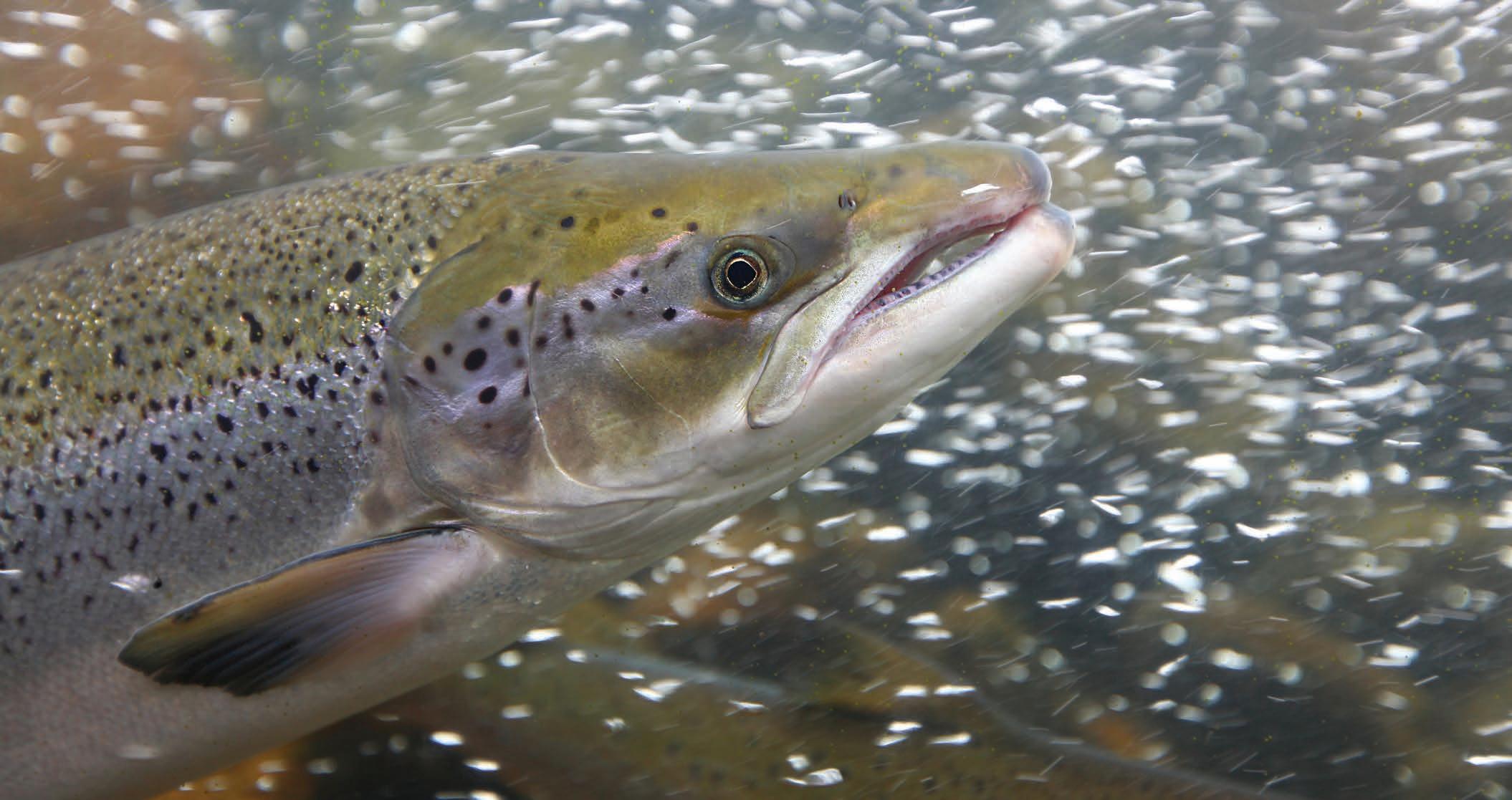
mum, help to produce fish that contain even lower levels of geosmin. These findings can ensure that best standard operating procedures and systems are available to commercial producers to help them guarantee that salmon harvested from RAS have a great flavor profile, without earthy or musty flavors. This in turn, should result in increased consumer demand for Atlantic salmon raised in water reuse systems, while reducing energy costs for system operation occurring during longer depuration periods, leading to increased business profits.
This research will also aid the development of effective therapeutic strategies to reduce losses of Atlantic salmon to saprolegniasis at early life stages. The identification of such therapeutic approaches will be highly beneficial to industry, both for RAS smolt production and landbased closed containment grow out and will enhance the fish welfare and economic viability of these operations. The results of this project will enable water-reuse facilities to effectively treat Atlantic salmon for saprolegniasis which will increase production.
Due to interactive partnerships that the UWSP NADF and TCFFI has with national and international aquaculture organizations such as the National Aquaculture Association, the World Aquaculture Society, and the Aquacultural Engineering Society, the outcome of this research will benefit facilities across a regional as well as global scale. Publications, hatchery manuals, white papers and other documents from the project will be made available online through UWSP NADF and TCFFI webpage and networking sites as the results are compiled.
For more information please visit UWSP NADF site aquaculture. uwsp.edu > Projects or TCFFI site www.conservationfund.org > Our Work > Freshwater Institute.
By: Greg Fischer¹, Emma Wiermaa¹, Chris Good², John Davidson², and Steve Summerfelt³ * ¹University of Wisconsin Stevens Point Northern Aquaculture Demonstration Facility, Bayfield, WI ²Conservation Fund Freshwater Institute, Shepardstown, WV ³Superior Fresh LLC, Hixton, WI Correspondence author: Greg Fischer at gfischer@uwsp.edu


